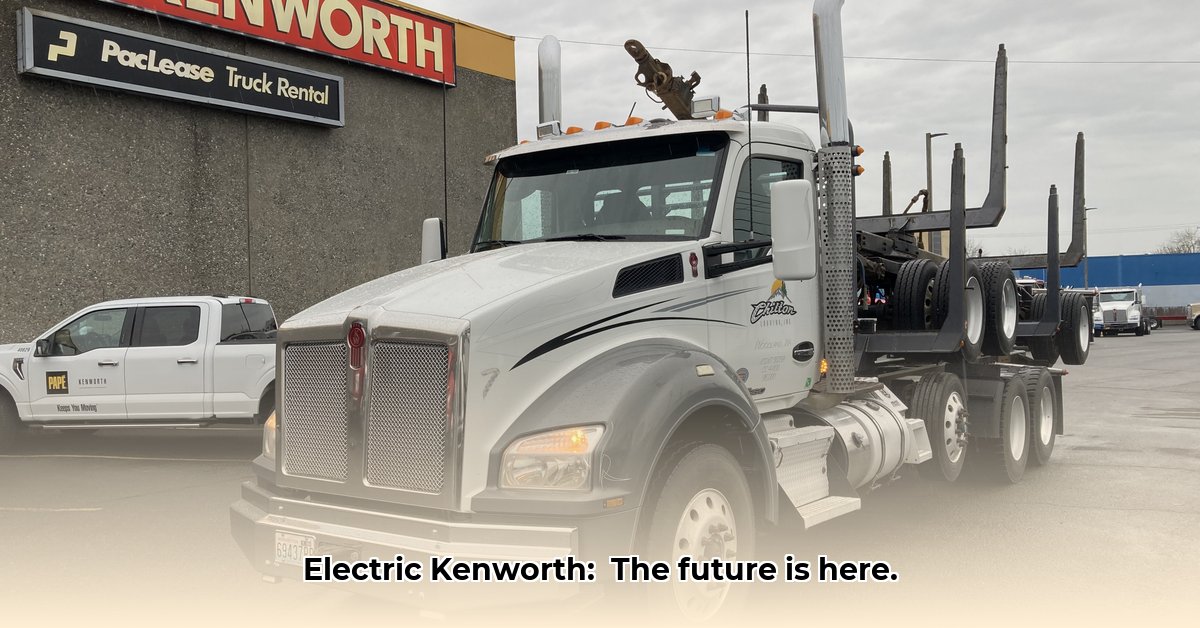
Papé Kenworth, a Portland-based Kenworth dealer, is leading Oregon's transition to electric trucking. This isn't just about selling electric vehicles; it's about building a sustainable transportation future for the state. This strategic move combines environmental responsibility with a sharp focus on a rapidly expanding market. But what are the challenges, and what opportunities lie ahead?
Oregon's Electric Trucking Revolution: Challenges and Opportunities
Oregon's trucking industry is undergoing a significant transformation, with electric trucks paving the way towards a greener future. This shift presents both exciting opportunities and considerable challenges. Papé Kenworth's role in this transformation is pivotal, as they navigate the complexities of this emerging market.
A Statewide Network: Expanding Access and Reliability
Papé Kenworth's extensive service network across Oregon is a key differentiator. This broad reach offers crucial support for electric truck owners, addressing one of the biggest concerns: downtime. Imagine a driver encountering an issue—instead of being stranded, they have quick access to service and repair. This infrastructure is vital for ensuring the practical viability of electric trucks, especially in a state as geographically diverse as Oregon. How will this enhanced accessibility impact the adoption rate of electric trucks in Oregon?
Diverse Electric Truck Solutions: Meeting Varied Needs
Papé Kenworth offers a diverse range of electric and fuel-cell Kenworth models, catering to Oregon's varied transportation needs. Popular options like the K270E and the T680 FCEV highlight their commitment to adapting to evolving technologies and market demands. This isn't a simple adoption of a new technology; it's a carefully curated selection of vehicles designed to meet the specific requirements of Oregon's unique trucking landscape. Will this tailored approach accelerate the adoption of electric trucks within specific sectors of Oregon's transportation industry?
Overcoming Hurdles: Addressing High Costs and Infrastructure Gaps
The significant upfront cost of electric trucks presents a major obstacle. The initial investment is substantially higher than for diesel counterparts, potentially deterring many businesses. Moreover, Oregon, like many states, faces a shortage of charging infrastructure, especially in rural areas. This limits the practicality of long-haul electric trucking. How can Oregon address this infrastructure gap to support the wider adoption of electric trucks?
However, experts are optimistic about overcoming these challenges. "The current hurdles are surmountable," says Dr. Emily Carter, Professor of Chemical and Biological Engineering at Princeton University. "Innovative financing models and targeted infrastructure development can significantly accelerate the transition."
Strategic Partnerships: A Collaborative Approach to Success
Papé Kenworth actively collaborates with businesses, providing guidance on navigating evolving regulations and incentivizing the adoption of electric vehicles. This proactive approach builds trust and positions them as leaders in the industry. Their commitment extends beyond sales, focusing on building long-term relationships and fostering the transition to electric transportation. What role can collaborative partnerships play in accelerating the transition to electric trucking?
A Roadmap for Success: Short-Term and Long-Term Strategies
The transition to electric trucking necessitates a coordinated strategy among various stakeholders:
| Stakeholder | Short-Term Goals (0-1 year) | Long-Term Goals (3-5 years) |
|---|---|---|
| Papé Kenworth | Expanding electric truck inventory, enhancing technician training, exploring innovative financing options. | Investing in charging infrastructure partnerships, lobbying for supportive government policies, developing comprehensive driver training programs. |
| Oregon Trucking Companies | Evaluating EV truck costs, exploring government incentives, assessing operational changes needed. | Gradually transitioning to electric fleets, integrating electric trucks into existing routes, potentially exploring fleet sharing models. |
| Oregon Government | Investing in strategic charging infrastructure, especially in rural areas, streamlining permitting processes for charging stations. | Implementing stricter emissions regulations, funding research in advanced battery technologies, incentivizing adoption of electric trucks. |
Mitigating Risk: Proactive Strategies for Success
Several risk factors could hinder the transition. A proactive approach to risk management is essential:
| Risk Factor | Likelihood | Impact | Mitigation Strategy |
|---|---|---|---|
| High Upfront Costs | High | High | Government subsidies, leasing options, innovative financing models. |
| Charging Infrastructure Gap | Medium | High | Public-private partnerships for charging station development, strategic charger placement. |
| Battery Technology Limitations | Medium | Medium | Continuous technological monitoring, selecting trucks with reliable battery technology. |
| Regulatory Uncertainty | Low | Medium | Close collaboration with regulatory bodies, proactive policy shaping. |
How to Mitigate High Upfront Costs of Electric Trucks in Oregon
The high initial cost of purchasing electric trucks poses a significant challenge for many Oregon-based trucking companies. However, several strategies can significantly reduce the burden:
Leverage State and Federal Incentives: The Oregon Clean Fuels Program offers substantial financial assistance, directly offsetting a large portion of the initial purchase price.
Prioritize Long-Term ROI: While the upfront cost is high, long-term cost savings from reduced maintenance and fuel (potentially free or low-cost electricity) make electric trucks a compelling investment. Analyze the total cost of ownership (TCO) for a comprehensive understanding.
Implement a Phased Approach: Don't rush into complete fleet electrification. Start with shorter routes to minimize risk and gain valuable experience.
Form Strategic Partnerships: Explore leasing options or partnerships with companies specializing in electric vehicle infrastructure and technology.
Advocate for Charging Infrastructure Development: Support the development of charging infrastructure, especially along frequently used routes.
The future of Oregon's trucking industry points firmly towards electrification. Papé Kenworth's proactive approach, combined with wider state-level initiatives, signals a promising path towards a cleaner, more efficient transportation future. While challenges remain, the collective effort towards sustainable transportation is undeniably gaining momentum.